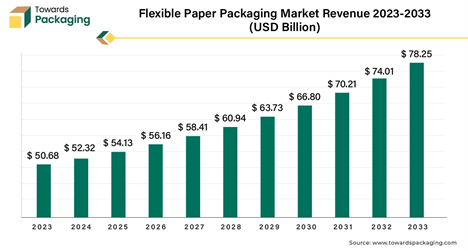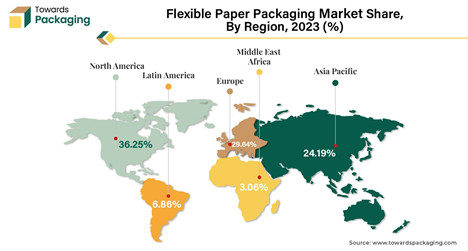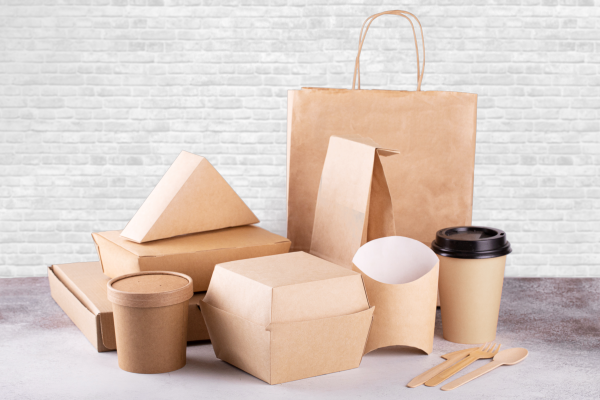One of the primary factors accelerating the growth of flexible paper packaging is the global move towards environmentally friendly and sustainable alternatives. The traditional plastic packaging solutions, though effective, are now viewed as unsustainable due to their contribution to environmental pollution. Flexible paper packaging offers similar protection as plastic but is made from renewable, fossil-free materials.
Flexible paper packaging products are devoid of materials like silicone, glassine, and laminations, making them lighter, typically under 100 grams per square meter. These features not only make them more environmentally friendly but also reduce the overall shipping costs and improve logistics efficiency. The demand for these solutions spans across various industries, including chocolates, pet food, personal hygiene products, and even meals.
Why Flexible Paper Packaging is Gaining Traction
The rising demand for sustainable packaging has made flexible paper packaging a highly sought-after option. A growing number of brands are recognizing the benefits of paper-based packaging over traditional plastics. The material is robust, safe for food, and can be easily printed on using both digital and analog printing technologies. This versatility makes it suitable for a variety of packaging needs, such as pouches, flow wraps, and bags, offering significant flexibility for manufacturers.
The cost-effectiveness of flexible paper packaging is also a major advantage. Not only does it provide longer shelf life for products, but it also helps brands reduce their carbon footprint, given the ease of recycling and lower emissions in production processes.

The global flexible paper packaging market is rapidly evolving, projected to reach an impressive USD 78.25 billion by 2033 from USD 50.68 billion in 2023. This significant growth is driven by the increasing shift towards sustainable packaging solutions, fueled by rising consumer demand, stringent regulations, and innovative product developments. The market is expected to grow at a compound annual growth rate (CAGR) of 4.58% between 2024 and 2033, indicating a robust upward trajectory for the sector.
Trends Shaping the Future of Flexible Paper Packaging
Several key trends are expected to shape the future of the flexible paper packaging market:
- Innovative Coatings: Recent advancements in coating technologies have allowed flexible paper packaging to become more resistant to external factors like moisture. These coatings enhance the durability and overall performance of paper packaging, making it a viable option for liquids and perishable goods.
- Digital Printing Revolution: The rise of digital printing has transformed the industry by offering greater customization options. Brands can now create personalized, visually appealing designs on flexible paper packaging, improving product branding and consumer engagement.
- E-commerce Growth: With the increasing prevalence of e-commerce and online shopping, lightweight packaging like flexible paper is becoming more popular due to its convenience, cost-saving potential, and the reduced waste generated during shipping.
- Sustainability Focus: Companies across various industries are pushing for sustainable packaging solutions. In the food & beverage industry, for example, there is a growing shift towards using paper-based materials to replace plastic, which is heavily influenced by consumer preferences for eco-friendly options.
 The Asia-Pacific (APAC) region is projected to grow at the fastest CAGR of 6.78% over the forecast period, driven by an expanding consumer base, increasing disposable incomes, and rapid urbanization. China and India, in particular, are witnessing a surge in e-commerce sales, which is expected to bolster the demand for flexible packaging solutions.
The Asia-Pacific (APAC) region is projected to grow at the fastest CAGR of 6.78% over the forecast period, driven by an expanding consumer base, increasing disposable incomes, and rapid urbanization. China and India, in particular, are witnessing a surge in e-commerce sales, which is expected to bolster the demand for flexible packaging solutions.
On the other hand, North America continues to lead the market, holding the largest market share of 36.25% in 2023. The region benefits from stringent environmental regulations aimed at reducing plastic waste and strong consumer demand for sustainable products. Furthermore, high recycling rates for paper packaging materials are pushing the region towards higher sustainability standards.
In Europe, regulatory frameworks and governmental initiatives supporting sustainable packaging practices have positioned the region as another critical market for flexible paper packaging. European consumers are increasingly adopting eco-friendly options, leading to the growth of sustainable packaging solutions across industries.
Segment Analysis: Leading Product Types in the Market
Among the various packaging types, pouches are leading the market with a 36.71% market share in 2023. This dominance can be attributed to several factors, including their lightweight and compact nature, which reduces shipping costs and storage space. Additionally, pouches help brands increase the number of products displayed on supermarket shelves, driving sales.
Applications Driving Growth: Focus on Food & Beverage
The food & beverages segment accounted for the largest share of 44.23% in 2023. The rise of on-the-go lifestyles has driven demand for portable, easy-to-use packaging formats, including pouches and wraps. Moreover, food companies are increasingly adopting sustainable packaging materials in response to consumer demand for eco-friendly alternatives.
Future Outlook and Market Developments
The flexible paper packaging market is poised for further growth, driven by regulatory policies, consumer preferences, and the commitment of companies to reduce environmental impact. Leading companies are continually innovating to offer sustainable, recyclable options that meet evolving market demands.
As environmental concerns rise, the flexible paper packaging market is becoming an essential solution for brands seeking to minimize their ecological footprint. With strong growth projections, innovative technologies, and increasing adoption across industries, the future looks promising for this market.
About The Author
Asmita Singh is a distinguished author and consultant in the packaging industry, recognized for her unwavering passion for knowledge discovery and her commitment to providing actionable insights. She holds an MBA from the University of Mumbai and a degree in Packaging Engineering from the Indian Institute of Packaging (IIP), equipping her with a solid foundation in both business and technical aspects of packaging. With extensive experience in packaging consulting, Asmita has successfully implemented advanced research methodologies across various packaging categories, including flexible packaging, rigid packaging, sustainable packaging, and smart packaging.








